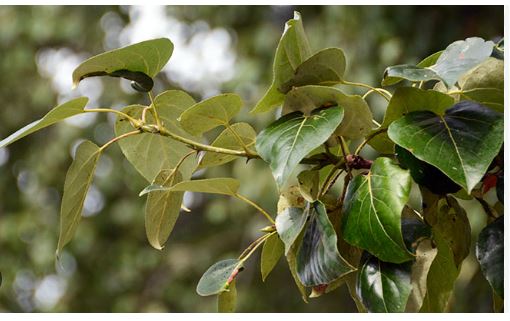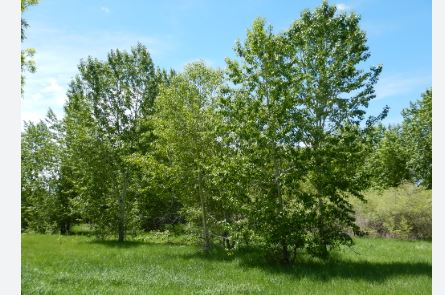
Botanical Classification
The Balsam Poplar, scientifically known as Populus balsamifera, is a member of the Salicaceae family, which encompasses willows, poplars, and aspens. It belongs to the genus Populus, specifically within the section Tacamahaca, which includes balsam poplars distinguished by their resinous, aromatic buds. Commonly known as balsam poplar, black poplar, or bam, Populus balsamifera is a deciduous tree closely related to cottonwoods (Populus deltoides) and aspens (Populus tremuloides). Its classification within the order Malpighiales aligns it with other fast-growing, temperate trees. The species name “balsamifera,” meaning “balsam-bearing,” refers to the fragrant, resinous buds that are a hallmark of this species.
History
Balsam Poplar has played a significant role in the cultural and ecological history of North America, particularly in boreal forest regions. Indigenous peoples, including the Cree, Ojibwe, and Inuit, utilized its sticky, resinous buds to create salves for treating wounds, burns, and respiratory ailments, leveraging their antimicrobial and anti-inflammatory properties. The wood was used for fuel, carving, and constructing shelters due to its abundance and ease of working. European settlers adopted it for similar purposes, and by the 19th century, it became important in forestry for pulp and light timber. Its role as a pioneer species in disturbed areas, such as floodplains and post-fire zones, has shaped northern ecosystems for millennia, with fossil records indicating poplars existed in the Tertiary period.
Identifying Characteristics
Balsam Poplar is a medium to large deciduous tree, typically reaching 60–100 feet in height with a trunk diameter of 2–5 feet. Its leaves are ovate to lance-shaped, 3–6 inches long, glossy dark green above, and pale beneath, with finely serrated margins. The buds are large, sticky, and resinous, emitting a distinctive balsamic fragrance, especially in spring. The bark is smooth and grayish-green on young trees, becoming deeply furrowed and gray-brown with age. Balsam Poplar is dioecious, producing male and female catkins on separate trees in early spring, followed by small, cottony seeds. Its narrow, conical crown and rapid growth rate make it a prominent feature in northern landscapes.
Distribution and Ecology
Populus balsamifera is widely distributed across North America, spanning from Alaska and Canada (Newfoundland to Yukon) south to Montana, Minnesota, and parts of northern New England. It thrives in boreal and temperate climates, favoring moist, well-drained soils in floodplains, riverbanks, wetlands, and lake margins. As a pioneer species, it quickly colonizes disturbed sites, such as post-fire or flood zones, often forming pure stands or mixing with willows, aspens, and conifers like spruce or fir. Balsam Poplar supports diverse wildlife, providing browse for moose and deer, nesting sites for birds, and habitat for beavers, which use its wood for dams. Its extensive root system stabilizes soils, preventing erosion in riparian zones.
Uses
Balsam Poplar has a range of ecological and practical applications. Its lightweight, soft wood is used for pulp, paper, plywood, particleboard, and lightweight crates, though its low durability limits structural uses. The resinous buds are harvested for medicinal purposes, creating salves and tinctures for burns, cuts, and respiratory issues due to their antimicrobial properties; they are also used in aromatherapy and perfumes for their balsamic scent. In landscaping, it is planted for erosion control, windbreaks, or as a fast-growing shade tree in wet sites, though its suckering habit and short lifespan (50–100 years) can be drawbacks in urban settings. Ecologically, it enhances soil fertility and supports biodiversity in wetland and riparian ecosystems.
USDA Zones
Balsam Poplar is hardy in USDA Zones 2–5, making it well-suited for cold, northern climates with long winters and short, cool summers. It tolerates extreme cold, surviving temperatures as low as -50°F, which supports its range in regions like central Canada and Alaska (Zone 2). Zone 5 includes milder areas such as southern Ontario, Minnesota, and northern Michigan. The tree requires moist, fertile soils and is intolerant of prolonged drought or high heat, restricting its cultivation in warmer or drier zones. Its cold hardiness and preference for wet sites make it an excellent choice for northern reclamation projects, riparian restoration, or landscapes in appropriate climates.

Cultivation of Balsam Poplar (Populus balsamifera)
- Site Selection: Choose a site with full sun to partial shade, as Balsam Poplar thrives in bright conditions but tolerates light shade. It prefers low-lying areas like floodplains, riverbanks, or wetlands with consistent moisture, mimicking its natural habitat.
- Soil Requirements: Plant in moist, well-drained soils with a pH of 5.5–7.5. The tree favors fertile, loamy, or silty soils but tolerates sandy or gravelly conditions if moisture is adequate. Avoid dry, compacted, or saline soils, which hinder growth.
- USDA Hardiness Zones: Cultivate in USDA Zones 2–5, where Balsam Poplar is hardy. It withstands extreme cold (down to -50°F) but is not suited for warmer climates above Zone 5 due to its intolerance of heat and drought.
- Watering Needs: Ensure consistent soil moisture, especially during establishment (first 1–3 years). Balsam Poplar tolerates wet soils and periodic flooding but requires regular watering in drier sites to support its rapid growth and prevent stress.
- Planting Time: Plant in early spring or late fall when the tree is dormant to minimize transplant shock. Bare-root or container-grown saplings are ideal, with spring planting preferred in colder regions to allow root establishment before winter.
- Spacing: Space trees 10–20 feet apart, depending on purpose (e.g., windbreaks, forestry, or ornamental). Balsam Poplar’s narrow crown allows closer spacing in group plantings, but wider spacing (15–20 feet) reduces competition in restoration projects.
- Propagation: Propagate via seeds, cuttings, or suckers. Seeds require no stratification but germinate best in moist, bare soil. Hardwood cuttings (8–12 inches), taken in late winter, root easily in moist media. Suckers from mature trees can be transplanted but may spread aggressively.
- Fertilization: Apply a balanced, slow-release fertilizer (e.g., 10-10-10) in spring during the first 2–3 years to promote growth. Mature trees rarely need fertilization in fertile soils but benefit from organic compost in nutrient-poor sites to enhance vigor.
- Pruning: Prune minimally in late winter or early spring to remove dead, damaged, or suckering branches. Maintain a single leader for a strong structure, as Balsam Poplar is prone to weak branching. Heavy pruning may encourage excessive suckering.
- Pest and Disease Management: Monitor for pests like poplar borers, aphids, or leaf beetles, which can damage foliage or wood. Use targeted insecticides for severe infestations. Fungal diseases like canker or leaf rust are managed by ensuring good air circulation and removing infected debris.
- Mulching: Apply 2–4 inches of organic mulch (e.g., wood chips or bark) around the base to retain moisture, regulate soil temperature, and suppress weeds. Keep mulch away from the trunk to prevent rot, especially in wet soils.
- Winter Care: Balsam Poplar is highly cold-tolerant, requiring no winter protection in its hardiness zones. Protect young trees from browsing animals (e.g., deer, rabbits) with tree guards or fencing, as they may target bark or twigs in winter.
- Landscape Use: Use Balsam Poplar for erosion control, windbreaks, or shade in wet landscapes, such as riparian zones or reclamation sites. Its rapid growth and attractive foliage suit rural or naturalized settings, but its suckering and short lifespan (50–100 years) make it less ideal for urban gardens.